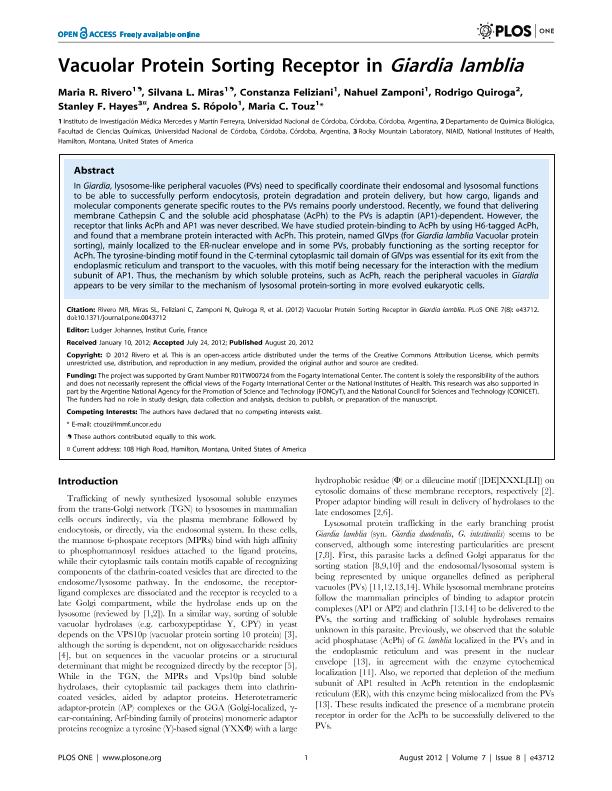Artículo
Vacuolar protein sorting receptor in giardia lamblia
Rivero, Maria Romina ; Miras, Silvana
; Miras, Silvana ; Feliziani, Constanza
; Feliziani, Constanza ; Zamponi, Nahuel
; Zamponi, Nahuel ; Quiroga, Rodrigo; Hayes, Stanley F.; Ropolo, Andrea Silvana
; Quiroga, Rodrigo; Hayes, Stanley F.; Ropolo, Andrea Silvana ; Touz, Maria Carolina
; Touz, Maria Carolina
 ; Miras, Silvana
; Miras, Silvana ; Feliziani, Constanza
; Feliziani, Constanza ; Zamponi, Nahuel
; Zamponi, Nahuel ; Quiroga, Rodrigo; Hayes, Stanley F.; Ropolo, Andrea Silvana
; Quiroga, Rodrigo; Hayes, Stanley F.; Ropolo, Andrea Silvana ; Touz, Maria Carolina
; Touz, Maria Carolina
Fecha de publicación:
08/2012
Editorial:
Public Library of Science
Revista:
Plos One
ISSN:
1932-6203
Idioma:
Inglés
Tipo de recurso:
Artículo publicado
Clasificación temática:
Resumen
In Giardia, lysosome-like peripheral vacuoles (PVs) need to specifically coordinate their endosomal and lysosomal functions to be able to successfully perform endocytosis, protein degradation and protein delivery, but how cargo, ligands and molecular components generate specific routes to the PVs remains poorly understood. Recently, we found that delivering membrane Cathepsin C and the soluble acid phosphatase (AcPh) to the PVs is adaptin (AP1)-dependent. However, the receptor that links AcPh and AP1 was never described. We have studied protein-binding to AcPh by using H6-tagged AcPh, and found that a membrane protein interacted with AcPh. This protein, named GlVps (for Giardia lamblia Vacuolar protein sorting), mainly localized to the ER-nuclear envelope and in some PVs, probably functioning as the sorting receptor for AcPh. The tyrosine-binding motif found in the C-terminal cytoplasmic tail domain of GlVps was essential for its exit from the endoplasmic reticulum and transport to the vacuoles, with this motif being necessary for the interaction with the medium subunit of AP1. Thus, the mechanism by which soluble proteins, such as AcPh, reach the peripheral vacuoles in Giardia appears to be very similar to the mechanism of lysosomal protein-sorting in more evolved eukaryotic cells.
Palabras clave:
lysosome
,
protozoa
,
receptor
,
soluble hydrolase
Archivos asociados
Licencia
Identificadores
Colecciones
Articulos(CCT - CORDOBA)
Articulos de CTRO.CIENTIFICO TECNOL.CONICET - CORDOBA
Articulos de CTRO.CIENTIFICO TECNOL.CONICET - CORDOBA
Articulos(INIMEC - CONICET)
Articulos de INSTITUTO DE INV. MEDICAS MERCEDES Y MARTIN FERREYRA
Articulos de INSTITUTO DE INV. MEDICAS MERCEDES Y MARTIN FERREYRA
Citación
Rivero, Maria Romina; Miras, Silvana; Feliziani, Constanza; Zamponi, Nahuel; Quiroga, Rodrigo; et al.; Vacuolar protein sorting receptor in giardia lamblia; Public Library of Science; Plos One; 7; 8; 8-2012; 1-14
Compartir
Altmétricas



